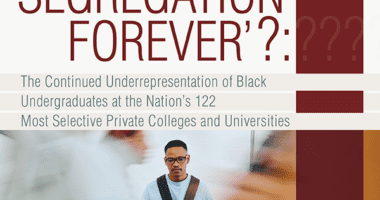Understanding Equality and Equity
Equality is a worthy ideal, but it presupposes that all people are afforded the same access, resources, and opportunities to succeed. Sadly, that’s never been the case in the U.S. Despite the adoption of essential legal protections — like the 14th Amendment, which holds that each person is entitled to the same rights, freedoms, and legal protections as others, regardless of their age, gender, identity, race, or sexual orientation; and Brown v. Board of Education and the Civil Rights Act of 1964, which outlawed racial segregation in schools and employment discrimination— we are seeing rollbacks to these established ideals. These protections are supposed to be the backbone of our democracy and a free society, but they’re insufficient on their own to counter deeply entrenched patterns of racial disadvantage in our education system and the U.S. more broadly.
Black and Latino students and students from low-income backgrounds continue to have unequal access to educational opportunities at every level — from preschool through college. They disproportionately attend underfunded schools and have less access to STEM and advanced coursework opportunities, and insufficient mental-health and social, emotional, and academic supports in elementary, middle, and high schools. Black and Latino students are more likely to have novice teachers and less likely to have teachers and faculty who look like them. They’re also vastly underrepresented in schoolbooks and curricula and at public and private colleges and universities. What’s more, students of color and their families have less money to pay for college — on account of pervasive systemic racism and racial wage and wealth gaps in the U.S. — and often borrow more and struggle with repayment as a result.
If we’re going to end these glaring disparities, Step One is to recognize that students of color start with fewer advantages and face more obstacles than many of their White peers.
Step Two is to move away from supposedly colorblind or color-neutral approaches that treat students the same, but, in fact, perpetuate White privilege and the unequal status quo, and consciously adopt evidence-based approaches that put equity first by treating students according to their individual needs and circumstances.
Some on the right may call that un-American, but, it’s anything but. As American legal scholar Martha Minnow points out, our federal laws already provide accommodations to people with disabilities and certain religious beliefs, while many schools provide personalized instruction, and no one is calling those things controversial or un-American.
What Does Education Equity Look Like?
All students — regardless of race, ethnicity, family income, zip code — are entitled to excellent educational opportunities and the resources and supports they need to succeed in school. ]
Education equity means fairness; and to achieve it, schools will need to provide additional resources and supports to underserved students and students who’ve experienced hardship.
Education equity means expanding access to high-quality early childhood education, sending additional funding to under-resourced school districts that collect less tax revenue and serve more students of color and students from low-income backgrounds who’ve long been given short shrift.
Education equity means creating more affirming and inclusive learning environments that support students’ social-emotional and academic development (SEAD) and make students feel seen and heard, and cultivating more welcoming campus climates at colleges and universities that value freedom of expression, student and faculty diversity, and a variety of perspectives.
Education equity means not shying away from race-conscious policies in the wake of the court ruling against affirmative action. It means recruiting and retaining more teachers of color, adopting more culturally relevant curricula, and allowing educators to teach honest history in the classroom. It also means expanding access to advanced coursework and AP courses that put students on the path to college and career success, expanding college access and affordability for students of color, undocumented students, justice-impacted students, and student parents; and ensuring that all students have the academic and mental health supports they need based on their unique needs.
Why Is Education Equity Important?
The short answer is that our future depends on advancing education equity. The U.S. student population is more diverse than ever before — more than half of all students enrolled in U.S. public schools are people of color, as are about half of all U.S. undergraduates, according to an American Council on Education report — but Black and Latino students are disproportionately relegated to segregated schools and colleges with less funding and fewer resources. This should be a national concern since the nation’s future is inextricably tied to theirs. By 2032, people of color will make up the bulk of our nation’s workforce, the Economic Policy Institute estimates. Unless we want U.S. companies and the economy to suffer, we can’t afford to leave these students behind.
So, it’s incumbent on educators and policymakers to ensure that every student has access to a well-rounded education and what they need to be successful. But it’s not just students of color who stand to benefit from equity, nor is it a zero-sum proposition. Education equity also benefits White students and can help them develop the 21st-century skills — like multicultural awareness, empathy, and an ability to think critically, problem-solve, and communicate and collaborate with people with different backgrounds and perspectives — that they’ll need to thrive in a globalized and fast-changing world.
At EdTrust, we won’t rest until each and every student has access to a nurturing and high-quality education that supports their growth and prepares them to flourish in adulthood and become good citizens.
Education equity may seem like a tall order, but America’s children deserve no less.









